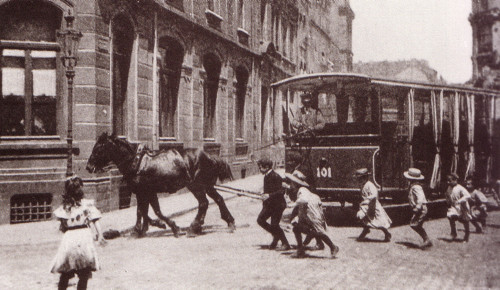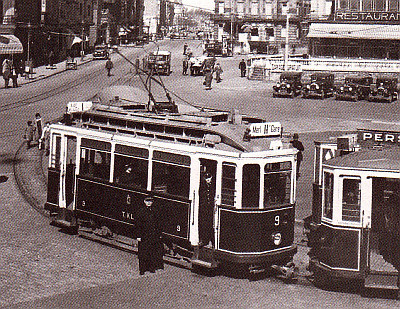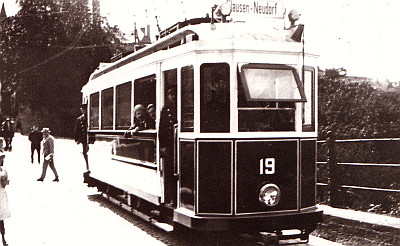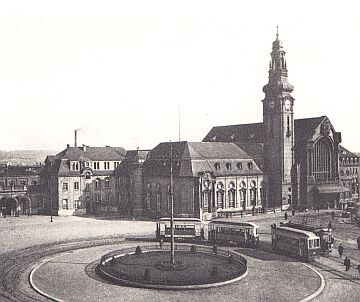

On October 4, 1859 somwhere outside the city of Luxembourg the railway station was built. The reason that this station was located outside to the city was because of military reasons. The city of Luxembourg was a fortress with walls around it. The military authorities ordered a requirement, that the station drive was to be placed outside of these fortifications, but on the other hand so close to these fortifications, that it would lie within shooting distance of that Fortress. Eventually the station was built in the territory of the commune of Hollerich at the place where it still lies today. The distance to the city centre was just not too long, so people could walk, but with a distance of 1400 meters it was not so very close to the centre. A hotelier soon introduced a horse omnibus. Not cheap, and thus only reserved for the happy few.

Around 1873 there were two plans simultaneously announced to introduce a horse tram. A ride with this tram would be much cheaper than with the omnibus, and thus within the financial possibilities of many more people. The two plans were:
The municipality of Luxemburg was willing to get a tramway, and chose in the Municipal Assembly of 3 June 1874 for Föral's plan. It was agreed, that the communityu would build the line, and that for operation the line a new society should be established, and that the profit (if more than a certain percentage) would be devided between the operator and the community of the city.
In the the plan there was the construction of a line with a length of 2223 meters, later to be expanded with a further 400 metres. There was chosen for the normal gauge of 1435 mm. This, because it was thought that there would be transit of railway goods wagons from the station to the city centre.
On september 8, 1874 the SATL (Société Anonyme du Tramway Luxembourgeois) was established, and soon the line was constructed. Allready within half a year the section Gare-Atheneum was opened on February 21, 1875. From 6:30 in the morning until 9 pm was driven only in connection to the trains, and then up to 20 hours in the evening there was a tram every 15 minutes. In the street that has nowadays the name Rue Joseph Junck (right in front of the station) a shed and a horse stable was constructed.
Again half a year later, on 24 August 1874 the rest of the line was opened, so that the line consisted of the piece Gare - Knuedler - Rue de la Reine - Grand Rue - Avenue de la Porte-Neuve. It soon became apparent that the timetable of once per quarter was not enough. There were so many people, that there were soon complaints about the service level. Soon more horse trams were deployed and the interval was reduced to a service of about 9 minutes. That the was profitable, was shown by the fact that in the year 1905 the balance was released on 150,000 frank profit. The number of horse-carriages is (to me) unknown, but at least there were seven. On the moment of constructing the stables the number of horses was said to be twenty horses.
Just after the turn of the century there came a new phenomenon in the picture. On February 17, 1906, a new plan was introduced to the municipality for construction of electric street lighting and the construction of an electric tram. And for thsi plan the community was happy to accept this modernity. There were a five plans for the construction of a tram, two of which were good, in such a way that they were discussed on 29 september 1906:

The municipal community chose for the plan to create a municipal corporation, that would be established according to the plans of Siemens-Halske. The SATL (the private company operating the horse tram operated) was bought out for 130,000 frank The municipal society TVL (Tramways de Ville de Luxembourg) was founded. In 1907 it was decided to build a tram depot in Limpertsberg and the construction was awarded to Siemens. Now there was chosen for a rail gauge of 1000 mm, a width that is less high costly. As for the catenary current a currency of 550 Volts was chosen.
Conversion of the existing (horse tram) line to metre track would mean that the line would be out of service for several months, something that was not acceptable. Fortunately, just in the same year the Pont Adolphe was constructed. It was therefore decided to create first a tram line from the station over this new bridge, and when it was put into service to change the old line (over the other viaduct) to the new meter gauge.
On June 27, 1908 the construction of the rails of the new line was ready. There were also available three new trailers. Only the electric installation was not yet ready. Nevertheless, the new tramline was already opened via the new line (over the Pont Adolphe and the Rue Aldringen to the Grande Rue). First with trailers that were intended for the electric tram, but propelled by horses. The old line was immediately broken up and converted to metres gauge.
On 31 July 1908 the electricity was ready, and there could be a test ride with one of the electric trams. On 8 August 1908 was the electric tram line officially opened. On 1 October the conversion of the old line was ready, and the new tram network was ready. As with the beginning of the horse tram, there were many complaints because of the heavy transport demand; crowded trams and many complaints were the result. The time of a stop lasted much too long, as a result of the many passengers getting in and out. The timetable could not be hold as planned. Soon there were two extra motor cars ordered in 1909.
During the following years, the number of lines gradually expanded. The number of motor vehicles and trailers was equally extended with these expansions. Under the tab "lines" each line is described separately, and under the tab "Rolling stock" you can find more about the rolling stock.
In the beginning there was no distinguishment between the four lines. From 1913 the four lines were identified with the colors green, white, yellow and red. New lines were designated by the name of the place that were situated on the end of the line. A uniform designation was introduced In 1925. Every line got a number.

Enlargement of the garage in Limpertsberg took place in 1922. Due to expansion of the number of lines the number of rolling stock was grown. In 1926 there came the first competitor of the tram in the scene. At first also of the TVL itself, as in that year by the society the first bus was purchased. The last network expansion took place in 1929, when line 12 was commissioned built through the Rollingergrund.
The second world war was not easy for the society, but the tram survived good, better than the bus section of the society. Most trams could continue driving, this opposite to the buses because of fuel poverty, and by the end of the war almost all busses were standing on the side. All indications and names had to be translated from French to German language. Signs A (of Arret) had to be replaced by H (of staging stelle), station names were changed in German language (Place du Gare became Bahnhofsplatz, etc), the name TVL (Tramway de Ville de Luxembourg) became EVSL (Elektrizitäts-und Verkehrsbetrieb der Stadt Luxembourg), the director was replaced by a German Director, etc. On 10 september 1944 the liberation of the city of Luxemburg came. In the time of the three trailers (numbers 112-114) were involuntarily sold to the city of Aachen, where they remained until 1959 under the numbers 802, 801 and 800.
Only shortly after the war the end of the tram was already visible. The tram was seen by many people as old-fashioned. A car was much more flexible, and soon was available for may people. In 1949, though on a small scale some trams were replaced by a bus. But when a major accident occurred in 1949 in Dommeldange between a car and the tram (riding on single track in the left side of the road), the end of the tram was final. In 1952 the first line shut down. Necessary improvements to the road to Neudorf had as result that tram line 9 was discontinued. Other lines soon followed. A large number of lines went out of service in 1955. Only two lines remained still a few years. In 1960, line 11 (to Merl) also was lifted, and finally on september 5, 1964 the last tram of line 10 from Heisdorf to Luxemburg was riding as the last tram. That farewell happened in style. A replica of the first horse tram drove together with the last tram of line 10 on the route of Heisdorf to Luxembourg.
For many people with the lifting of the tram rails the progression had come. Now no old-fashioned tram anymore, but a modern car and modern buses. But after a number of decades the large numbers of cars and buses that are passing te city become a nuisance. Since the 1990s there are serious thought in Luxemburg about a new tram line. No more old-fashioned, single track, left riding, slow tram of then, but modern, articulated tram carriages. How these plans became reality, and when a new tram will ride, that is something outside the framework of this website. To read more about the modern tramline, go to my website about the tramline in the city of Luxemburg.

This page is part of the Websites of Wim Kusee